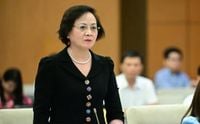Vietnam is undergoing a historic and transformative administrative reform set to reshape its provincial and communal governance structures by 2025. The Government has proposed an ambitious plan to rearrange and consolidate administrative units across the country, aiming to streamline operations, improve governance quality, and boost socio-economic development.
At the heart of this reform is the reorganization of provincial-level administrative units. Currently, Vietnam has 63 provinces and centrally governed cities, but the Government's submission to the National Assembly Standing Committee outlines 23 options to merge 52 existing provincial-level units into 23 new ones. This will result in a total of 34 provincial-level administrative units: 6 centrally governed cities and 28 provinces. The newly formed provinces include well-known areas such as Tuyên Quang, Yên Bái, Thái Nguyên, Phú Thọ, Bắc Giang, Hưng Yên, Hải Phòng City, Đà Nẵng City, Ho Chi Minh City, Cần Thơ City, and others.
The plan was discussed in detail during the National Assembly Standing Committee’s 46th session on June 5, 2025, where Minister of Home Affairs Phạm Thị Thanh Trà presented the comprehensive proposal. Eleven provincial-level units, including Hanoi and Huế, will remain unchanged due to meeting existing standards or special characteristics.
One of the key details is the management of human resources following the rearrangement. The total staff allocated for provincial agencies across the 52 provinces and cities undergoing the merger is 447,657 people, encompassing 2,321 cadres, 79,118 civil servants, and 366,218 public employees. Importantly, the Government has committed that the number of provincial-level cadres, civil servants, and public employees after the rearrangement will not exceed the total before the merger. Over a five-year period, staff streamlining will be implemented alongside restructuring efforts to enhance the quality and efficiency of the workforce.
Regarding infrastructure, there are currently 38,182 public offices among the 52 provinces and cities involved in the rearrangement. Of these, 33,956 offices will continue to be used, while 4,226 will become surplus. The Government has issued clear directives on the management and financial handling of these surplus assets, emphasizing the need to prevent waste and ensure effective use, though officials acknowledge that resolving these issues will take multiple years.
The reform extends beyond the provincial level to the communal level, which is even more extensive. Vietnam currently has 10,035 communal-level administrative units, including communes, wards, and towns. The Government’s plan involves rearranging 9,907 of these units, with 128 units remaining unchanged due to meeting size and population criteria or possessing unique characteristics such as geographic isolation.
Following the rearrangement, 3,193 new communal-level units will be formed, consisting of 2,498 communes, 682 wards, and 13 special zones. This will reduce the total communal units nationwide to 3,321, a dramatic decrease of 66.91%, cutting 6,714 units. This consolidation aims to create larger, more viable administrative units capable of better governance and resource management.
Minister Phạm Thị Thanh Trà highlighted that the arrangement of communal-level staff will largely involve transferring district-level cadres to the new communal units. Initially, the number of cadres, civil servants, and public employees at the communal level will not exceed the total before the rearrangement, excluding provincial and district staff reassigned to communes. Similar to the provincial level, staff streamlining and quality enhancement will be pursued over five years.
The National Assembly Standing Committee unanimously approved the principle resolutions on communal-level administrative unit arrangement on June 5, 2025. The resolutions are underpinned by strict standards set forth in Resolution No. 76/2025/UBTVQH15, ensuring that 95.08% of new communal units meet or exceed these criteria. For those that do not, the Government has applied special provisions acknowledging practical constraints.
One of the most critical challenges of this reform is the selection and placement of key personnel, especially at the communal level. National Assembly Chairman Trần Thanh Mẫn stressed the importance of appointing commune chairpersons and other leaders who possess a deep understanding of state management and sufficient experience. With over 1,000 district-level tasks and numerous provincial-level responsibilities being delegated to communes, leadership quality is paramount.
Chairman Mẫn emphasized, “The goal is that strong communes lead to strong provinces, and strong provinces lead to a strong central government. All policies now focus on the communal level for implementation.” He further cautioned that simply transferring provincial-level cadres to commune leadership roles may not always be appropriate and underscored the need for rigorous training and careful personnel evaluation.
To support this, the Government’s Steering Committee issued Official Letter 11/CV-BCĐ, providing detailed guidelines on the standards and criteria for new communal-level civil servant positions. The letter outlines three core principles for personnel arrangement: adherence to Politburo and Steering Committee directives, ensuring required qualifications and experience, and maintaining objectivity and fairness in personnel decisions.
Civil servants at the communal level must exhibit strong political commitment, loyalty to the Party and people, integrity, and a high sense of responsibility. Educational requirements generally include a university degree relevant to the position or equivalent practical experience. Leadership roles require additional political theory qualifications, with allowances made for those completing required training. Special provisions exist for ethnic minority cadres and those working in economically disadvantaged areas, requiring them to achieve university-level qualifications within five years.
The Government has also addressed the transition process for cadres and civil servants, ensuring continuity of salary and benefits during the initial six months following reassignment. Leadership allowances will be temporarily suspended until new regulations are issued, reflecting the reform’s complexity.
Handling the surplus public assets, including offices rendered redundant by mergers, remains a pressing concern. Chairman of the National Assembly’s Economic and Financial Committee, Phan Văn Mãi, urged the Government to develop a dedicated plan to manage these assets effectively, warning that without immediate action, unresolved issues could accumulate over the next three years. He also emphasized the importance of adjusting regional master plans and socio-economic development strategies to align with the new administrative boundaries.
Deputy Secretary of the National Assembly Party Committee, Vũ Hải Hà, shared insights from recent field surveys conducted with General Secretary Tô Lâm in five pairs of merged provinces. These surveys identified challenges such as cadre arrangements, surplus office management, housing for relocated staff, and infrastructure connectivity, including roads and airports. Local governments have requested that provincial and communal units begin operations simultaneously to ensure unified leadership, a proposal slated for Politburo consideration on June 6, 2025.
Financial management in the new administrative units also demands close attention. Deputy National Assembly Chairman Nguyễn Đức Hải highlighted the complexities of budgeting for merged units and called for proactive support mechanisms for cadres facing relocation or redundancy.
To facilitate the reform’s implementation, the Government has mandated ministries and agencies to simplify administrative procedures, enhance guidance, and establish hotlines to address localities’ concerns promptly. The Ministry of Science and Technology is developing an AI-powered assistant to help officials and citizens navigate new regulations and procedures, with a demonstration scheduled for mid-June 2025.
The Politburo and Secretariat, through Conclusion No. 160-KL/TW issued on May 31, 2025, have expressed strong support for the reform efforts, commending the dedication of central and local Party committees and agencies in advancing the complex and demanding tasks. They have underscored the need for continued leadership, coordination, and rigorous monitoring to ensure timely and effective implementation.
All new communal-level administrative units are set to begin operations on July 1, 2025, with provincial-level units following by August 15, 2025. This phased approach will allow for adjustments and training to ensure smooth transitions.
Ultimately, this sweeping administrative reform marks a pivotal moment in Vietnam’s governance evolution. By consolidating administrative units, optimizing human resources, and enhancing leadership quality, the Government aims to create a more dynamic, efficient, and responsive local government system that can better serve its citizens and drive national development.





